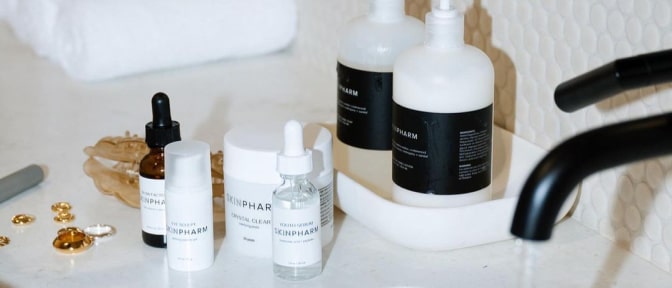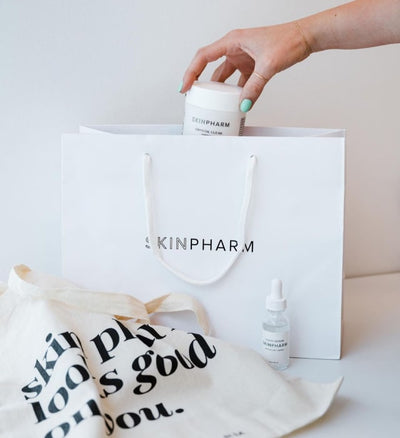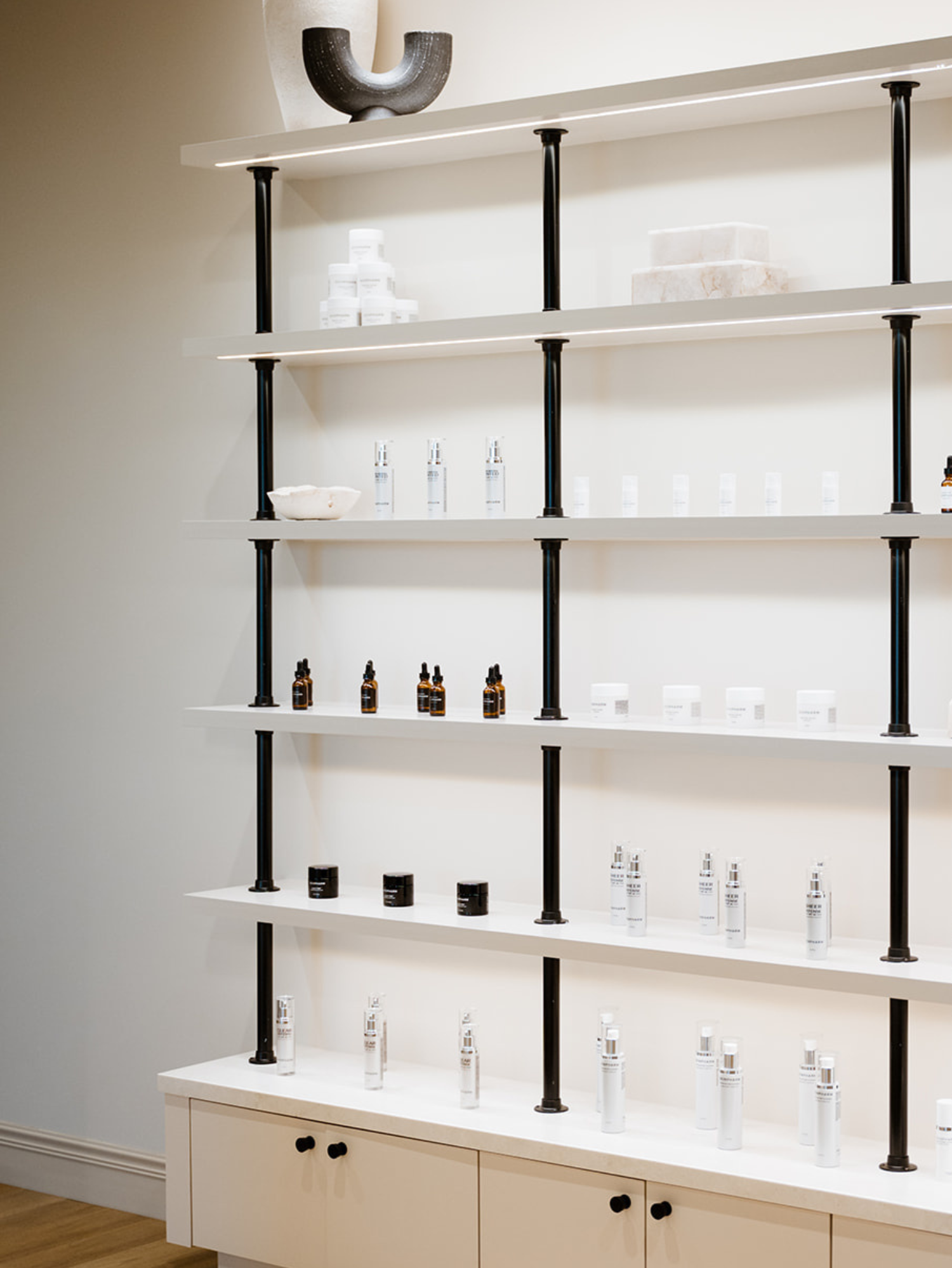Shop skin care
Clinics
VISIT OUR 9 CLINICS →
HOURS
Monday – Friday
9:30a – 5:30p
How to Use Glycolic Acid + Vitamin C Together

Picking skin care ingredients to use together can make you feel a bit like a mad scientist.
If you’re going it on your own, it often comes down to trial and error. Unfortunately, an error can mean that your skin becomes irritated or even looks worse than before.
Instead of learning the hard way, being armed with the knowledge of which skin care ingredients pair well together and which don’t can make those decisions much more manageable.
If you’re wondering whether or not you can combine glycolic acid and vitamin C, Skin Pharm is here to give you all of the information you need.
What is glycolic acid and how does it work?
Skin care ingredients can be confusing, with so many different benefits, potential side effects and recommendations. Looking at them on a one-on-one basis can help clear up a lot of the mystery, so you know what each ingredient is and what it may be able to do.
Let’s start with glycolic acid.
Glycolic acid falls into the alpha-hydroxy acid (or AHA) category. The category is filled with heavy hitters and is a go-to for many skin care providers.
While manufactured synthetically for skin care products, AHAs are organic acids found in nature in things like sugar cane and dairy. In addition to glycolic acid, other acids in the AHA category include lactic acid, acetic acid, tartaric acid, citric acid and malic acid.
Specifically, glycolic acid exists in sugar cane, pineapples, grapes and beets. It is perhaps the most influential member of the AHA group, especially when it comes to its exfoliating properties.
It does this by dissolving the bonds between dead skin cells present on the skin’s surface. With these bonds loosened, there is far less holding them together. That means they are much easier to gently shed, leaving behind brighter, smoother, more glowy-looking skin.
The key to its effectiveness is in its size. Glycolic acid has one of the smallest molecular sizes of all of the hydroxy acids. That allows it to break through the layer of dead skin cells with far more ease than other skin care ingredients. Its size also helps it be less abrasive and less like a bull in a china shop as it does.
In addition, glycolic acid (and all AHAs) are water-soluble. With the main target of glycolic acid being the skin’s surface, this is a huge benefit.
If you’re looking for something to work deeper inside the skin, you may want to turn instead to a beta-hydroxy acid (or BHA) as they are oil-soluble and able to enter the pores.
GLYCOLIC ACID BENEFITS:
Molecular size, water-solubility, hydroxy acids — how does all of that transition into actual benefits?
With all of that in mind, glycolic acid can:
- Help prevent breakouts: Glycolic acid has known antibacterial properties, specifically working on one of the bacteria tied to blemishes (Propionibacterium acnes, or P. acnes). That means it not only exfoliates the skin to keep the pores open, but also reduces the risk of developing blemishes in the future.
- Improves skin texture: All of that exfoliation leads to the skin constantly renewing itself at a much faster rate than it naturally would. The impact of that is smoother, firmer, softer and more even skin with less visible fine lines and wrinkles.
- Reduce hyperpigmentation: As the skin turns itself over quicker and quicker, it takes with it a lot of the skin cells that have been impacted by hyperpigmentation. While nothing can entirely remove dark spots, glycolic acid can help to fade them significantly.
- Increase skin hydration: Due to glycolic acid’s water-soluble status, using it helps improve your skin’s hydration.
What is vitamin C and how does it work?
As skin care powerhouses go, vitamin C is high up on the list.
With so many factors that impact the skin’s appearance related to the damage done by free radicals (molecules that are missing an electron), vitamin C’s antioxidant status is a huge advantage.
Antioxidants can either lend or share one of their electrons with free radicals, which neutralizes them and stops them from doing damage. Otherwise, free radicals will continue to bounce around inside the body, stealing electrons from anything they may come across.
Vitamin C is an intrinsic part of the skin, especially in the dermis and epidermis. It is found in its highest levels in the epidermis, primarily because it protects and supports the skin.
However, as the body ages, the natural levels of vitamin C start to decline. The sun can also speed up its degradation, so those who spend more time in the sun are likely to have naturally lower levels.
Possibly the vitamin’s most important role is in how it impacts collagen production, though. It is a regulatory factor in the synthesis process. Vitamin C also helps to bind the collagen together after it is produced.
As a quick reminder, collagen is the most abundant protein present in the body. It makes the skin more vital, firm and plumper – all things that significantly impact how old the skin may look.
However, just like vitamin C, collagen also starts to degrade as we age. Keeping as much of it as possible is one of the most important goals of any skin care routine.
VITAMIN C BENEFITS:
Antioxidants are essential to not just your skin but your entire body. But what does that mean for your appearance? Vitamin C’s benefits include:
- Protection against sun damage: While it doesn’t absorb UVA or UVB rays like sunscreen does, it is a great product to work as a supporting character alongside it. It helps to minimize the harm done by any rays that can make it through your sunscreen, helping to stave off the premature aging effects they can have.
- Smoothing fine lines and wrinkles: There is a reason that vitamin C is included in so many skin care products that focus on combating the aging process. With consistent use (over a few months), vitamin C can help plump and smooth the skin.
- Boosting collagen production: Even though collagen is naturally present in your skin, it begins to degrade as you age. Unfortunately, the amount of collagen that is produced just can’t keep up.
Vitamin C is an essential component of the collagen production process. It not only encourages new collagen growth but can help protect and maintain the collagen you do have.
How to use glycolic acid and vitamin C together
Luckily, you can use glycolic acid and vitamin C together. That way, you can combine the fantastic, skin-transforming benefits of both in your skin care routine.
If you’re looking for a skin care duo to help you achieve the dewy, radiant, even skin of your dreams, look no further. But is there an optimal way to successfully combine them?
When using glycolic acid and vitamin C together, you’ll always want to start with your glycolic acid product. The easiest way to do this is by incorporating it into your cleanser or using our Crystal Clear clarifying pads.
We loves these pads, as they utilize not one but two alpha-hydroxy acids (glycolic acid and lactic acid). They also include a beta-hydroxy acid, salicylic acid, to penetrate deeper into the pores.
That way, after you apply, you can also remove dead skin cells as you swipe the pad across your face — leaving the product behind to continue to work.
Once done, you have a clean, blank canvas and open pores.
Following that, it’s time to apply your vitamin C. Look for a product that has a more biologically active form, like 10% L-ascorbic acid, so that it can get to work on your face right away.
Our Glow Factor is perfect for this use, as it combines L-ascorbic acid with 0.5% ferulic acid and antioxidants. Shake gently, then apply it directly to your clean, dry skin, allowing time to absorb before moving on.
That way, the vitamin C can penetrate deeper into the skin without having to fight its way through as many dead skin cells.
If you follow those tips, you’ll likely notice a difference in your skin after about four weeks of consistent usage. You may want to start slow, especially with the Crystal Clear clarifying pads, to allow your skin time to adapt.
Some people choose to use them every other day to minimize the risk of irritation, but always listen to your skin. If you have sensitive skin, combining glycolic acid and vitamin C twice a day, every day, can just be too much.
To wrap things up...
Using glycolic acid and vitamin C together can have a massive, positive effect on your skin — if done in the right way. Applying your glycolic acid product first to clear the skin, followed by your vitamin C product, means that both products can be as effective as possible.
Their combined benefits can overhaul your skin, leaving it dewy, more even and radiant. When you’re ready to get your best skin and own the body you’re in, Skin Pharm is here for you.
SOURCES:
Cosmetic and dermatologic use of alpha-hydroxy acids | PubMed (nih.gov)

















